Darwin
Have you been to Darwin? I have been to every capital city in Australia except Darwin, the capital of the Northern Territory. The rest of my family have come here over the years because of work commitments but despite traveling through a lot of northern Australia, I hadn’t been to Darwin. About 53% of the population of the Northern Territory live in the capital.
It is known for its multicultural population with about 70 groups of different ethnic backgrounds calling Darwin home. This reflects the history of the Northern Territory and Darwin in particular and has resulted in famous street markets, featuring food from every corner of the World.
The warm climate and coastal position promotes a relaxed feeling. The surrounding coastline is very beautiful but you need to be mindful of crocodiles anywhere near water.
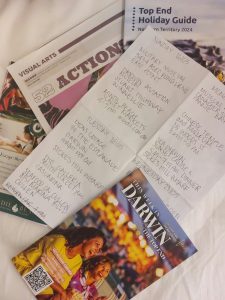

Only had five days to see everything so planned carefully. We had intended to spend six days, but Virgin canceled our flight after we had checked in and we couldn’t go until the next morning!
My first real memories of Darwin are from Christmas Day, 1972, when Cyclone Tracy devastated 80% of the City, killing 71 people and injuring hundreds more. Before the anemometer was smashed by the cyclone, wind gusts reached 217km/h, 255mm of rainfall fell in twelve hours and at least 70% of the houses suffered serious structural failure.
More than 36 000 people left Darwin, filling every plane arriving with supplies, equipment and specialist personnel. Government intervention resulted in the Darwin Reconstruction Commission and most of the City was rebuilt within three years. The degree of destruction led to the introduction of improved building codes across Australia.
The ferocity, the timing and the loss of so many people remains embedded in the memory of many people, myself included. It was a sombre Christmas Day.
I have discovered modern Darwin is a vibrant and diverse City. We started our break with a list of museums. The Military Museum included a lot of information about the bombing of Darwin. Really well presented with interactive opportunities. The film about the Japanese bombing the town was compelling viewing but also really awful. Lots of interesting artifacts.
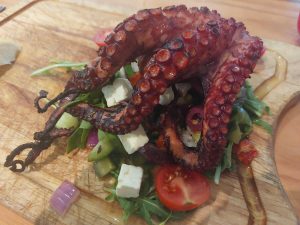

Lunch, overlooking the water, was a nice break between museum.
Next was the Darwin Aviation Museum. My father was in the Air Force so I found the second World War information really interesting. Lots of aeroplanes and helicopters on display. Really surprised by the size of the B52 Bomber.
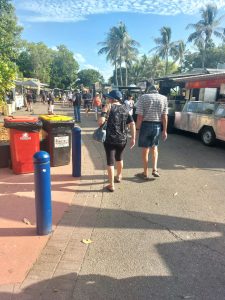

So many different food vans and the market smelt wonderful!
Later that day we went to the Mindil Beach Markets. Pity we’d had a great lunch because the food stalls were all enticing. Settled on a leg rub instead. The three other ladies having massages when my husband and I arrived were also tourists. They came from Busselton, just south of where we live in Perth. Small world.
I’d been really looking forward to the Museum and Art Gallery. We’d enjoyed a lovely breakfast of bacon and eggs at a cafe in Cullen Bay. The hotel buffet breakfast was a bit sad. So, great coffee and nice food, off to the Museum and Art Gallery overlooking the water.
The first exhibition, 52 ACTIONS was a collection of works ‘addressing the themes impacting the World today.’ These were the works of contemporary artists reflecting on the role of art as a political motivator, resulting in a change of perspective. I read all the descriptors and liked some of the artworks but some of them left me puzzled.
Another exhibition was about Cyclone Tracy. The deaths and devastation was shocking. This was a really interesting gallery but very sad, too. Next was the exhibition of Year 12 Practical Arts Students. I like to go to our local gallery in Perth to see the work of the graduating students and marvel at the materials now available in schools.
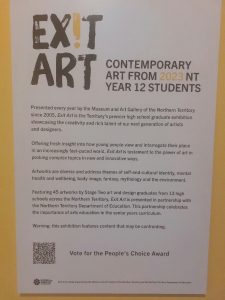

There is a huge shift from drawing, painting and using materials to make objects to digitally enhanced photos. Interestingly, many of the students wrote about their ethnic group and traditions and customs along side their works. These were very introspective pieces.
We wandered through the museum, admiring Sweetheart, a huge crocodile, and other creatures, painted, pinned and photographed. Ended up in the shop. I love the shops in art galleries and museums. I’ve bought scarfs, books, cards and fridge magnets. Traveling light, so no shopping this time.
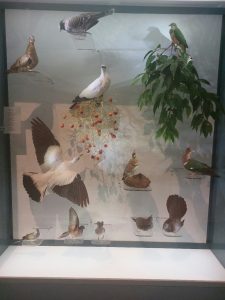

We could hear birdsong everywhere around Darwin. I enjoyed the displays in the museum as I could identify a few of the birds we’d seen.
We visited the Chinese Temple and Chinese Museum. The Chinese Temple is a rebuild on the original temple site, built in 1887. The existing temple was built on the same site after Cyclone Tracy destroyed the previous temple, rebuilt after the Japanese bombing of Darwin in 1942. Unusually, Buddhism, Taoism and Confucianism are all practiced in this temple.
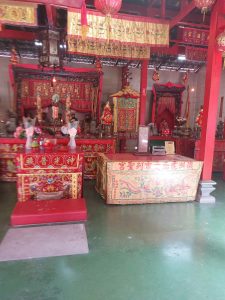

Many Chinese came to Australia seeking gold. Most of the Chinese in Darwin were shop keepers or fruit and vegetable growers. The artifacts in the museum tell the stories and traditions of Chinese families in Darwin.
Glad we went to Darwin. I realised I only had a fairly sketchy knowledge of the Japanese raids on the area, I heard and read personal stories of people who were in Darwin when Cyclone Tracy hit and read histories of the various ethnic groups who called Darwin home. There’s every sort of cuisine available and lots of opportunities to acquire Aboriginal art.
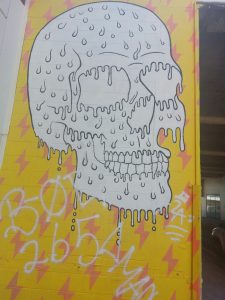

Really liked the masses of street art.
I found the heat tiring but locals kept telling us we were there at the best time as it is awful during ‘the wet.’
